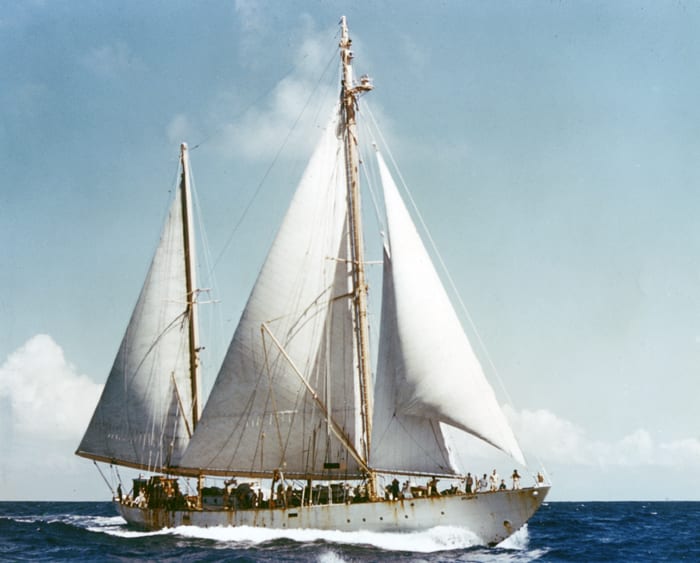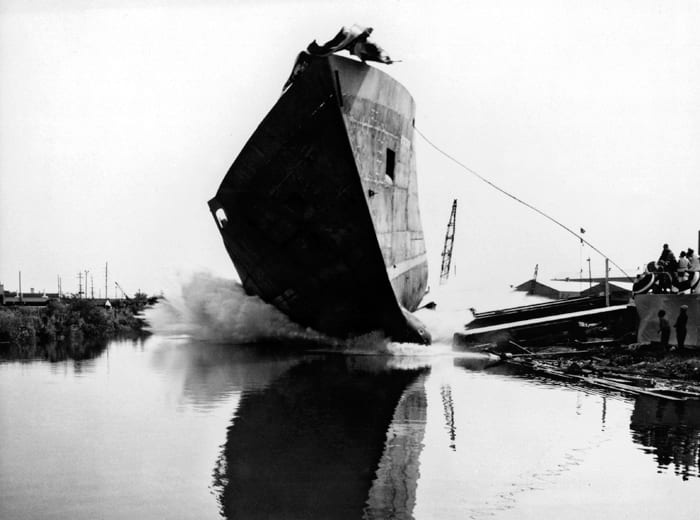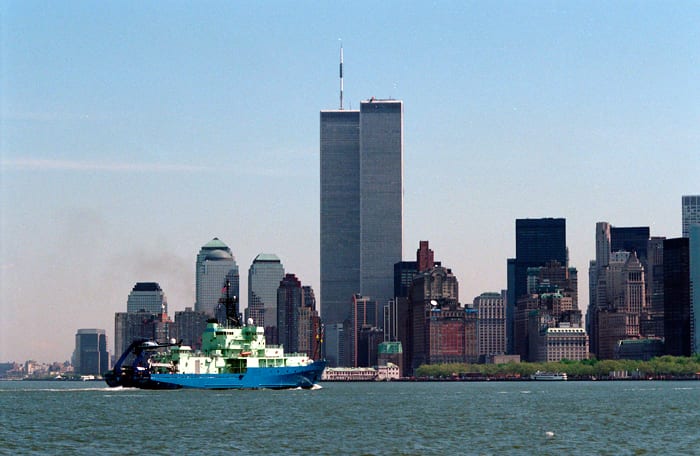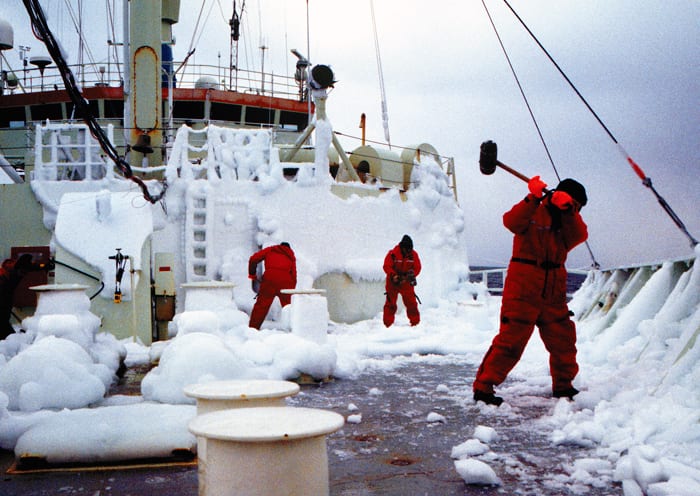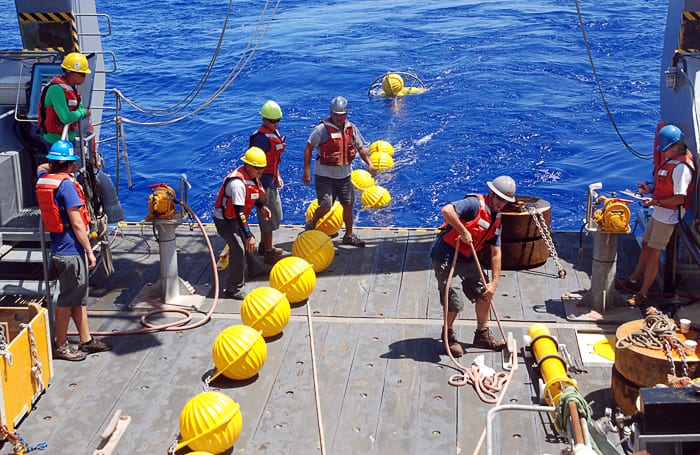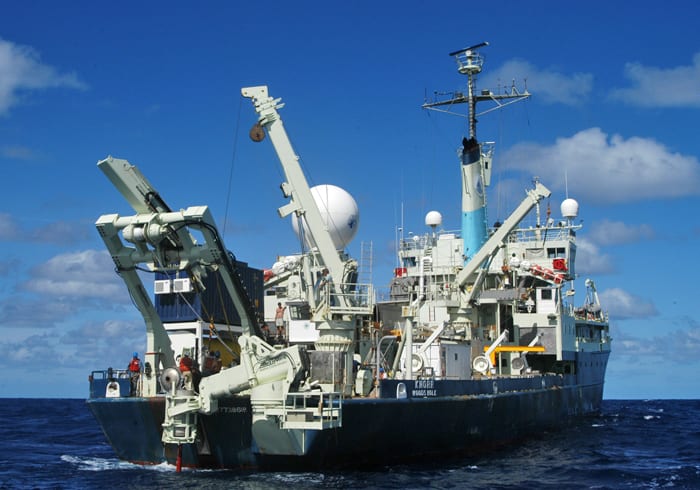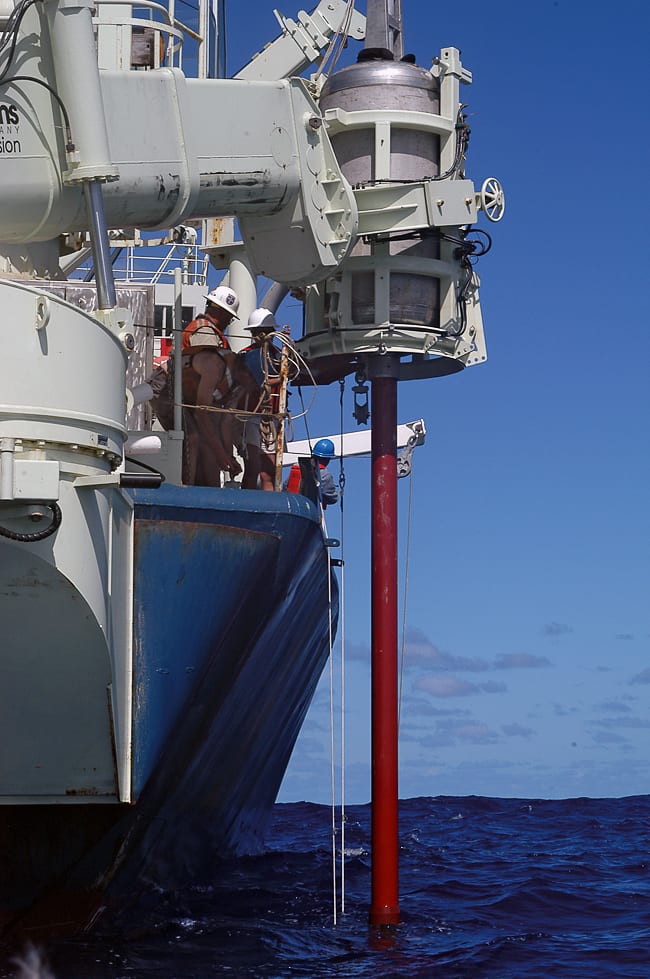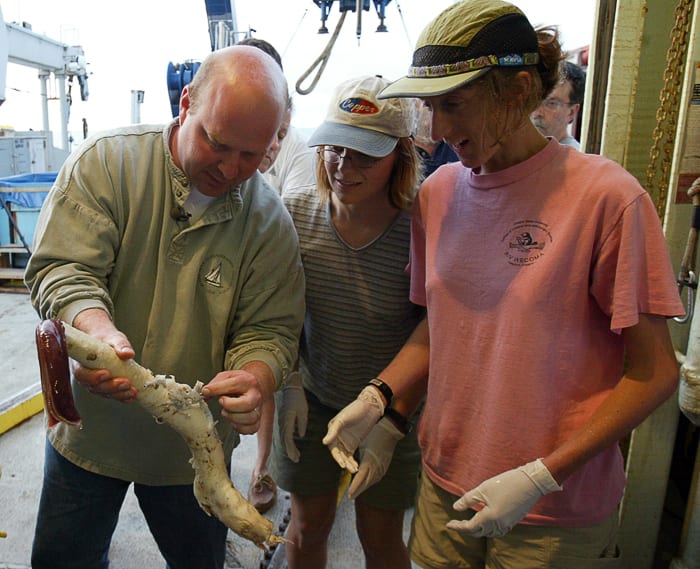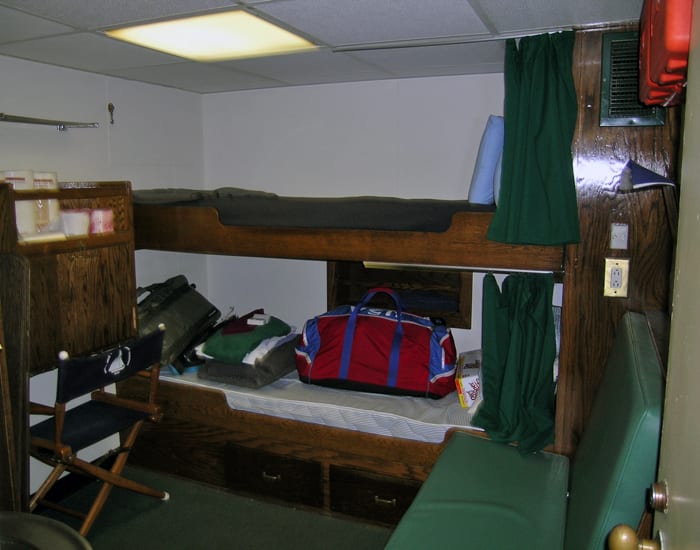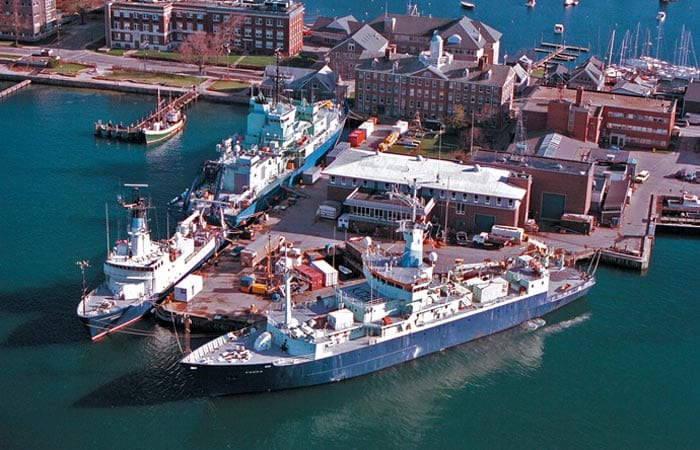
A Long Voyage to Get a New Ship
WHOI will operate research vessel slated to join U.S. fleet in 2015
On a cold, blustery day in April 1997, hundreds of people swarmed Iselin Dock at Woods Hole Oceanographic Institution (WHOI) to welcome Atlantis into the nation’s oceanographic research fleet. Politicians and other government officials lined the decks as the 274-foot-ship eased its way in. The crowd cheering on the pier almost drowned out a local college band heralding Atlantis, the new support ship for the submersible Alvin and a symbol of WHOI’s status as a world-class research ship operator.
Atlantis had taken more than 10 years to design and build, and Dick Pittenger, vice president for marine operations at WHOI, was aboard, celebrating its long-awaited arrival. But even then, he had started thinking about the next new ship.
“You can’t rest on your oars,” he said to himself. “You’ve got to get on with it.”
Pittenger knew well that from concept to keel, the process of acquiring new ships is long, arduous, and fraught with pitfalls. He also knew that, like children, ships grow older before you know it. In only a decade or so, WHOI’s two other large research vessels, Knorr and Oceanus, would be nearing the end of their service lives.
So with Atlantis in full bloom, he began sowing seeds that would begin to bear fruit 13 years later, when WHOI was selected to operate one of two new ships that will join the national research fleet. If all goes according to schedule, the ship will come into service by 2015.
Boom times for exploratory science
Few realized it at the time, but the welcoming of Atlantis also signaled the end of a golden era for U.S. research vessels. Between 1989 and 1997, 10 large- and intermediate-scale ships were either built or retrofitted by the Navy, the National Science Foundation (NSF), or private institutions.
By 2003, however, times, and the economy, had changed. The nation was fighting two wars, and the talk was of national security, not frontier exploration. As federal deficits climbed and budgets shrank, oceanographic research fell lower on the list of national priorities. In the last decade, only four ships have been added to the national research fleet, which has diminished from 33 to 21. Pittenger, who was Oceanographer for the Navy before he came to WHOI, knew that federal support for the nation’s research fleet has always proceeded in roller-coaster cycles.
When WHOI was established in 1930, it used funds from a private endowment to commission the building of the original Atlantis, a 143-foot ketch. Atlantis was the first American ship built specifically for oceanographic research.
During World War II and early in the Cold War, the Navy dramatically increased funding for basic oceanographic research, which paid huge dividends in enhancing the Navy’s effectiveness in its watery theater of operations, especially in submarine warfare. But America’s research fleet still consisted mostly of refitted military ships, yachts, and supply vessels.
The early 1960s were a boom time for basic science. The nation’s space program ramped up, and while NASA engineers were building Saturn rockets and Apollo space capsules, ocean engineers and scientists at WHOI were designing Alvin, a human-occupied submersible that would lead to momentous discoveries in the deep ocean. The 1960s brought an influx of federal funds to design and build ships specifically for doing marine science. Twenty new research ships came online during the decade, including WHOI’s Knorr.
Inner and outer space
Exploration of space and the ocean had similarities, but how the nation pursued the two was quite different. The space program was a high-profile endeavor that featured astronaut heroes and a visual goal of landing men on the moon. Its goals and assets were, and still are, guided by a central federal agency, the National Atmospheric and Space Administration (NASA).
Oceanography, on the other hand, was a much more diffuse enterprise paid for and influenced by at least three federal agencies: the Navy, NSF, and to a lesser degree, the National Oceanographic and Atmospheric Administration (NOAA). It involved multiple ships working at the same time and researchers at many institutions.
Even today, NASA owns and operates the space shuttle fleet, but ships in the national oceanographic research fleet are owned by several departments of the federal government, primarily the Navy and NSF, or by individual academic institutions. But each ship is operated by an institution, such as WHOI, which is responsible for maintaining the vessel and providing the crew.
The host institution does not control where the ship goes or who gets to use it. That task falls to the University-National Oceanographic Laboratory System, or UNOLS, a consortium of 61 universities and institutions involved in oceanographic research.
At present the UNOLS fleet boasts 21 ships at 16 institutions. Knorr, Atlantis, and Oceanus are UNOLS vessels, the first two owned by the Navy, the last by NSF. The Navy-owned ships have both a name and a designation as a numbered Auxiliary General-purpose Oceanographic Research (AGOR) ship. The current Atlantis, for example, is also known as AGOR-25.
Researchers all over the country, including ones who don’t work at a UNOLS institution, can submit proposals to use UNOLS ships. Balancing ships and scientists, UNOLS coordinates ships’ schedules and itineraries as efficiently as possible. Nearly 60 percent of the scientists working on WHOI-operated UNOLS ships have come from other institutions, and WHOI scientists often go to sea on ships based elsewhere.
Revitalized after a dry spell
By the early 1980s, the space shuttle program was in high gear and NASA rolled out Atlantis, Columbia, Challenger, Discovery, and Endeavour. Each of these was named after a famous seafaring vessel.
Meanwhile, funding for oceanography had dropped low enough to put the U.S. research fleet at risk. Ships that dated back to World War II had become obsolete, no new ships were in the works, and ships built during the flush days of the ‘60s were approaching middle age and would need to be refitted and updated to extend their service lives.
Navy Secretary John Lehman, appointed by President Ronald Reagan, recognized that the nation’s research fleet was on the verge of obsolescence. His concern was not strictly scientific; knowledge of the oceans was crucial to maintain the Navy’s readiness to detect and confront threats at sea. In 1984, Lehman and Chief of Naval Operations Adm. James Watkins issued a policy statement declaring the research fleet a Navy priority. They committed millions of dollars to build four new research ships, including Atlantis, and to overhaul six others, including Knorr and Oceanus, both of which had been built by NSF. For comparison, the space shuttle Endeavour cost $1.7 billion.
WHOI rode the Lehman/Watkins-led wave of ship funding through the 1990s. In seven hectic years, Pittenger and his staff had sold the old Atlantis II. They had overseen the lengthening and overhaul of WHOI’s research vessel Knorr to extend its life for another decade. They had refitted a third WHOI ship, Oceanus, and won bids to operate the new Atlantis, giving the institution a fleet that would take it into the 21st century.
At the same time, Navy officials also had the forethought to begin laying the groundwork to build four more new vessels. Two would replace Knorr and its sister ship Melville, which would need to be retired in 2015. The other two new ships might replace other aging vessels but potentially could expand the fleet, if all other ships remained in service.
Though encouraged by the news that the fleet would be getting new ships, Pittenger knew that the new ships would probably be considerably smaller than so-called “Global Class” vessels such as the 279-foot-long Knorr. The Navy had proposed a new “Ocean Class” class of vessels that were intended to cost less to build and operate than Global Class ships, without compromising scientists’ ability to stay out for weeks at a time and venture into the most forbidding seas.
Through UNOLS, the oceanographic community argued that building smaller ships was false economy. A Global Class ship could carry more scientists and equipment, accomplishing more on each cruise, than a smaller ship, scientists said. In the long run, bigger ships would be more efficient, and they were also required for certain kinds of equipment and experiments. A smaller ship, for instance, wouldn’t be able to handle the Long Core, a one-of-a-kind instrument designed at WHOI to collect cores of sediments up to 50 meters deep into the seafloor.
Nevertheless, in July 2002, the Navy made it official: It was ready to proceed with plans for four new ships—but the ships would be the smaller, Ocean Class, size.
Summit in Salt Lake City
The Navy is expert in building warships, not research ships. Unlike military or commercial ships, research vessels must accommodate people who’ve never been to sea before and who may have physical disabilities. Deck spaces must be flexible to fit a variety of scientific missions. Labs must be outfitted to handle hazardous chemicals and store specimens, from microscopic to massive.
For input on all the details, from deck fittings to the number of berths to the width of the ship’s passageways, federal agencies turned to the science community. The Navy, NSF, and NOAA mandated a UNOLS-sponsored committee to devise Scientific Mission Requirements, or SMRs, for each class of ship.
This is the stage where oceanographers get their one big chance to persuade the agencies of their vision and needs for new research ships. The guidelines then are fashioned into specifications that architects and shipyards will use in the formal design process—with very little additional input from the scientists.
Soon after the Navy announcement that it would build new ships, UNOLS invited 70 people involved with the fleet to landlocked Salt Lake City, where the group spent tense hours hashing out the SMRs for the new class of ship. Some participants struggled with the idea of designing a smaller ship. For years oceanographers had been calling for more Global Class ships like Knorr and Atlantis. How would they develop guidelines for a ship they thought would be too small to meet their needs? What would they have to give up? What were they willing to give up?
“It was a challenging process,” recalled Al Suchy, director of ship operations at WHOI. “We had to pare down the requirements so we could get an Ocean Class ship.”
Even seemingly minor details could affect the design in major ways. Increasing the number of scientists that a ship can host, for instance, means not only more berths, but also more storage space for food, water, and gear. Each additional person could add up to 50 tons to the ship’s displacement, according to Pittenger and Suchy.
Coming to consensus
After the meeting, some members of the group began composing the formal SMR document. With each draft they circulated, scientists and ship operators from around the country chimed in with suggestions. A year later, in March 2003, UNOLS approved the 60-page final draft and sent it to the Navy, NSF, and other interested parties. The science community, through its grassroots process, had spoken. From here on, the design and development of these new ships would be largely out of its hands.
The guidelines were specific enough to give designers a good idea of what the scientists needed, but vague enough to be applicable for a variety of budgets and a range of ship sizes from 180 feet long, barely bigger than Oceanus and with space for just 20 scientists, to 220 feet long, about midway between Oceanus and Atlantis.
The final SMR document recommended a ship with berth and workspace for 25 scientists. It included provisions for adequate deck space, and necessary cranes, winches, and cables to maneuver scientific equipment. It called for features such as anti-roll tanks, so the ship could venture into the roughest waters of the North Atlantic and Southern Ocean; and a Dynamic Positioning system to keep the ship on a target point in up to 8-foot seas and 35-knot winds. It suggested low noise and vibration to prevent interference with sensitive sonar and other instruments; and a relatively fuel-efficient engine to reduce operating costs down the line. It requested living features such as ample portholes to provide natural light; pleasant (i.e., non-military) color of walls, floors, and furnishings; sleeping and recreational spaces suitable for people who are not experienced sailors; passageways wide enough to accommodate people with disabilities; and alarms that can be noticed by blind or deaf workers. And it envisioned flexibility to adapt to tools and technologies not yet invented.
In short, the group asked for ships that could do what a Global Class ship could do, even though they were smaller. It was like asking for all the features of a Cadillac, even though the group knew they were getting a Camry.
More competition for less funding
Even building an economy car takes money, and WHOI officials knew that a bumpy road still lay ahead. In the mid-2000s the federal budget came under increasing strain. In addition, UNOLS and the Navy found themselves competing for funds against another new and ambitious oceanographic endeavor.
The NSF and NOAA had lobbied successfully for the Ocean Observatories Initiative (OOI), a system of instrumented moorings and cabled networks working in concert with autonomous underwater robots that would be placed at key locations in oceans around the world. The multimillion-dollar, multi-agency project has the potential to transform ocean-based science by relaying continuous streams of data via satellite to scientists on land, instead of intermittent data collected from scientists based on ships.
Many UNOLS institutions, including WHOI, have played key roles in OOI since the initiative began, while also seeking to maintain funding for ship-based research. They argue that while moored observatories can tell us a lot about the parts of the ocean where they’re placed, they can’t replace shipboard science. They can’t follow moving water or animals, and they can’t respond to unexpected events such as an oil spill or a tsunami-generating earthquake—as UNOLS ships have done in recent years. Besides, large research ships will be needed to deploy, maintain, retrieve, and gather data from the hundreds of instruments OOI will require. Whatever else the government wanted to fund for ocean research, the fleet still needed new ships.
UNOLS pressed its case hard, and finally, in July 2009, the Navy announced that despite a bad economy and shifting priorities, it had budgeted $176 million for two identical Ocean Class research ships, not four as planned in 2002. Each of the new ships, designated AGOR 27 and 28, would incorporate berthing for at least 20 scientists and the ability to stay at sea for up to 40 days and cruise at 11 knots. Other details would be worked out in the formal design phase.
Balancing costs and desires
The long wait for funding accentuates a problem with the SMR process, according to Mike Prince, who was the executive secretary of UNOLS in 2002 and who co-authored the SMR document. Today, in addition to his work with UNOLS, Prince is the representative from the Office of Naval Affairs (ONA), which provides funding to other Naval departments and outside parties involved with the Ocean Class ships. His new vantage point in ONA has provided him with insights on the scientific community’s involvement in the ship design process.
In Prince’s view, the SMRs should be just the first step in visualizing and designing a ship, not the final word—especially in this case, because so much time has elapsed since the SMRs for these ships were written. He thinks that if the Navy allowed the scientific community to provide input in a controlled formal process as the designers fleshed out all the details, the result could be an even better ship.
“It’s like buying a house—you could work with the architect and spend more money, but you’d get a better result,” he said. “Now that I’m involved, I keep finding areas where I wish we had done a better job.”
Others think the SMR process is fine as it is and that the Navy is right to limit how much input the scientific community can give later in the process.
“You can imagine all the different ideas about what this ought to look like,” said Robert Munier, who became vice president of marine operations at WHOI in 2010. “Someone has to be the referee, and that ends up being the Navy.”
Despite his reservations about the process, Prince is excited about the fact that the Navy is bringing two state-of-the-art ships online in the next few years, and he said he was convinced that the community will be happy with the results.
“The reality is that we have huge deficits and until that changes, we won’t have big increases in funding for science,” he said. “But the fact that we’re still building ships—that’s positive and real. Everything else is a desired goal for the future.”
Start the bidding
Shortly after the Navy announced the new ships, it convened a meeting to explain the process. An institution hoping to be chosen to operate one of the new ships had 60 days to submit proposals. The two most important selection criteria were the institution’s qualifications for operating the vessel and how its research program related to Navy research priorities, Prince said.
Institutions had to include a cost estimate to operate and maintain the ship over a period of years, an outline of institutional facilities and resources that would benefit the new ship, and any prior experience in ship building and operation. The winning institutions would also have to send a representative to work with the Navy at key points throughout the design and construction process. Finally, each winning ship operator would need to retire a ship from service. Nobody’s fleet was going to grow.
Most of the time, oceanographers at UNOLS institutions work together collegially. After all, there are only so many ships, so much time at sea, and so much money to go around. But come time to bid for a new ship, it’s every institution for itself.
For institutions that do a lot of oceanography, there are several reasons to want to operate at least one UNOLS vessel. The main reason is that ships create scientific opportunities, to which scientists at the host institution usually have first access. An institution with ships will have more engineers, technicians, and crew members with more skill and experience handling scientific equipment at sea, than institutions without ships.
Operating a UNOLS ship also brings in money. Ship operators get federal grants that pay for research done using the ship. These grants help pay for institutions’ basic operating expenses. At WHOI, grants for shipboard science provide about 20 percent of the institution’s overhead income.
And, of course, operating a research ship enhances the institution’s reputation as an oceanographic powerhouse. WHOI is renowned for its seagoing and ship management expertise, honed through decades of ship operation. WHOI administrators were determined to uphold that legacy.
Even though WHOI’s ship Knorr was scheduled for retirement, that didn’t mean WHOI would automatically win a contract to operate one of the new ships. The Institution would have to compete in a bidding process just like everybody else. And WHOI wasn’t the only ship operator worried about its aging vessels.
At the Navy meeting for potential bidders, representatives, from WHOI, the University of Rhode Island (URI), Scripps Institution of Oceanography in La Jolla, Calif., Oregon State University, the University of Washington, and the University of Miami, were cordial to each other. But underneath their civil exterior lay a vein of cutthroat competition. There was a lot at stake, and everybody knew it.
“Everyone was kind of holding their cards—they were being very friendly, but basically they were saying that they would be deadly serious about winning the competition,” said Dick Pittenger, who represented WHOI along with Terry Schaff, WHOI’s director of government relations at the time. Looking around the room, Pittenger noted that URI had sent five representatives, and Scripps had sent three. They were serious about winning one of the ships. The WHOI team would have to work extra hard to make their proposal stand out above the rest. The game was on.
WHOI makes its case
By then, Pittenger had officially retired as vice president of marine operations, but he teamed with Susan Humphris, who succeeded him, and Suchy to write the 75-page proposal highlighting WHOI’s accomplishments and capabilities.
“We had already done some quiet ‘what ifs’ and ‘who’s going to propose?’—trying to understand what we’d need to do to beat the others,” Pittenger said.
WHOI had eight decades of experience in ship operation. Just in the span from 2004 to 2008, WHOI research ships completed 198 successful cruises on behalf of the entire oceanographic research community: Fifty-nine percent of the participants on those cruises were from institutions other than WHOI.
In addition to describing WHOI’s abilities to operate and manage a fleet of ships, the proposal also included a plan to introduce the new ship to the public. When Atlantis was launched in 1997, it embarked on an outreach cruise to Washington, D.C., and New York City. Hundreds of legislators, other governmental officials, and students were invited aboard to tour the ship and learn about ocean research. The cruise was a huge success, and WHOI intended to do the same with the new Ocean Class ship.
As the October 2009 deadline neared, the writers got down to nitty-gritty details such as how future fuel prices should be estimated. Pittenger, Humphris, and Suchy crunched the numbers again and again and finally decided on a budget they thought was realistic, though probably higher than that of their competitors. Pittenger said prospective ship operators often underestimate the costs of running a ship, making their proposals attractive to funding agencies. But when the ship arrives and busts the budget, those operators can run into problems. WHOI’s proposal writers felt their budget reflected the institution’s hard-won wisdom gained from decades of operating research vessels—and counted on the Navy to recognize that.
Each of the three co-authors brought varied strengths, Pittenger said. Humphris’ background as a scientist using ships and her writing skills, for example, complemented the others’ experience with the Navy and ship operations, he said.
With all the details in place, and satisfied that they had produced a solid proposal, the WHOI team e-mailed their bid to the Navy. Then they waited.
The December holiday season came and went, spring arrived, and finally, so did the news: Four institutions had submitted bids, and WHOI and Scripps had been chosen to operate the new Ocean Class vessels.
“WHOI’s outstanding proposal was the unanimous recommendation for operation of the Ocean Class research vessel, AGOR 27,” said U.S. Navy Rear Adm. Nevin Carr, the chief of Naval research. “I am pleased to continue ONR’s long and fruitful association with WHOI as a premier operator of Navy research vessels for the betterment of Navy and our nation’s ocean science programs.”
“WHOI is honored and thrilled with the opportunity to continue to serve the ocean science research community at a time when the need for increased ocean observations is so important,” said WHOI President and Director Susan K. Avery.
The next ship in a long line
In many ways, the voyage to the new ship is just beginning. The Navy has begun the formal design phases, guided by the SMRs and limited new input from WHOI and Scripps. Two shipyards are vying for the contract: The Washington-based shipyard Dakota Creek Industries, teamed with Guido Perla and Associates, and the Wisconsin-based shipyard Marinette Marine Corporation, teamed with Glosten Associates, are working on confidential plans. Their challenge is to fit the SMRs within the $88-million budget allowed for each ship’s construction, Suchy said.
“There are a lot of players who want or need something,” said Christopher MacDonald, a project manager with PEO Ships, the Navy department tasked with overseeing all the details involved in the construction of the AGOR ships. His job is to make sure the designer/yard teams keep the project on time and budget, while maximizing the specifications desired by scientists.
“There’s always that tension [of wanting to do] more for the ship … even for me the tendency is strong,” he said. “I want to provide a great ship for the science community, but the reality is that the budget is what it is.”
“This process is structured to try and keep costs down—to stay within the budgets and meet as many requirements as we can,” Prince said. “I think it will do that—but ask me again in six months.”
The Navy plans to choose the winning design by the end of September 2011, with construction slated to start a few months later. In Navy documents, it will retain its designation as AGOR-27, but sometime this fall the Navy will choose the name the world will know it by.
If all goes according to schedule, WHOI’s new ship will be delivered in late 2014 and be operating at full capacity in 2015. It will replace Knorr, one of two WHOI ships that Pittenger knew back in 1997 would be nearing the end of their service lives sometime after 2010. The other ship, Oceanus, will be retired by its owner, the NSF, at the end of 2011.
For Pittenger, the bid to operate AGOR-27 is one more battle won. After years of worrying about funding for the research fleet, coming to terms with the Navy’s decision to build smaller ships, and assembling competitive bids for new ships, he’s savoring the moment. Taking the bad with the good is just part of the challenge of managing a fleet of research ships.
“It’s a labor of love at some level,” he said. “But the payoff is worth the pain.”
Slideshow
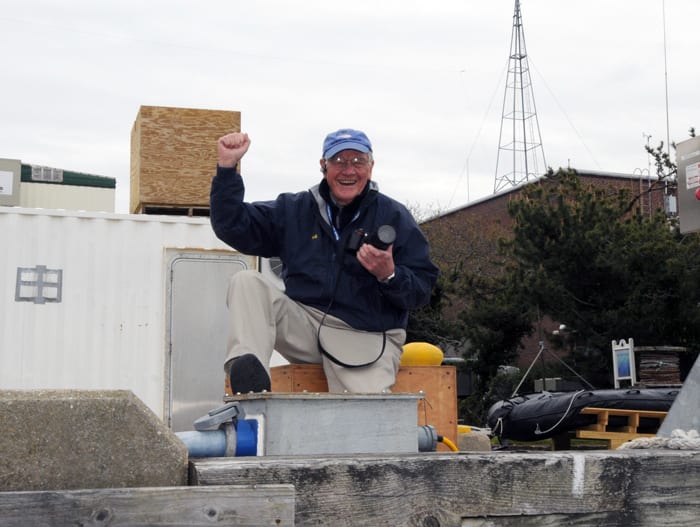
Slideshow
 Navy Admiral (ret.) Dick Pittenger, former vice president for marine operations at WHOI, was part of a team that led WHOI's winning proposal to operate a new research vessel for the nation's oceanographic fleet. It will be built by the Navy. (Photo by Jayne Doucette, Woods Hole Oceanographic Institution)
Navy Admiral (ret.) Dick Pittenger, former vice president for marine operations at WHOI, was part of a team that led WHOI's winning proposal to operate a new research vessel for the nation's oceanographic fleet. It will be built by the Navy. (Photo by Jayne Doucette, Woods Hole Oceanographic Institution)- Atlantis was one of the nation's first dedicated research vessels capable of venturing into the open sea far beyond the shoreline. Purchased with funds from a private endowment, it operated out of Woods Hole from the founding of WHOI in 1931 until 1964. (Photo by David M. Owen, Woods Hole Oceanographic Institution)
- R/V Knorr, which will be retired when the new WHOI research ship is built, first entered the water in Bay City, Michigan on Aug. 21, 1968. Since then it has traveled more than one million miles in the service of oceanographic research. Knorr, which is owned by the U.S. Navy and operated by WHOI, received a major overhaul in 1989 and was refit in 2005 to carry the Long Core. (Photo courtesy of Woods Hole Oceanographic Institution)
- The new and current R/V Atlantis was launched in 1997. One of its first duties was an outreach tour to Washington, D.C. and New York City. Hundreds of government officials and students were invited aboard to learn about ocean research. WHOI will make a similar effort with its new research ship, which is scheduled to launch in 2014. (Photo courtesy of Woods Hole Oceanographic Institution)
- To withstand the rigors of waves, wind, and sometimes ice, oceanographic research vessels must be large, sturdy, and well designed. Here, Capt. A.D. Colburn, right, crew member Bill Dunn, and others use ice mallets to break up ice that formed on the foredeck of R/V Knorr during a research cruise in the Labrador Sea. (Photo by George Tupper, Woods Hole Oceanographic Institution)
- During deployment of a buoy, the busiest area of a research vessel is the fantail, the portion of the deck near the ship's stern. What looks like mayhem is actually a highly organized and precisely choreographed procedure for getting the buoy, along with miles of line studded with dozens of delicate instruments (and with bright yellow, buoyant hardhats), into the water without tangling, damaging the equipment, or injuring any people involved. (Photo by Penny Foster, Woods Hole Oceanographic Institution)
- R/V Knorr, like other large research ships, carries an impressive array of equipment including winches, cranes, an A-frame for deploying and retrieving buoys and other heavy objects, and satellite and radio antennas. Knorr, however, is the only ship in the world outfitted to handle the Long Core, which collects seafloor sediment cores and weighs 30,000 pounds when fully assembled. (Photo by Alexander Dorsk, Woods Hole Oceanographic Institution)
- The Long Core barrel on R/V Knorr is stowed on the deck when not in use, then positioned vertically to be lowered to the ocean floor where it can extract sediment cores up to 45 meters (150 feet) long. Knorr was strengthened in 2005 to accommodate the Long Core and withstand the intense force needed to retrieve it with its load of sediment. (Photo by Alexander Dorsk, Woods Hole Oceanographic Institution)
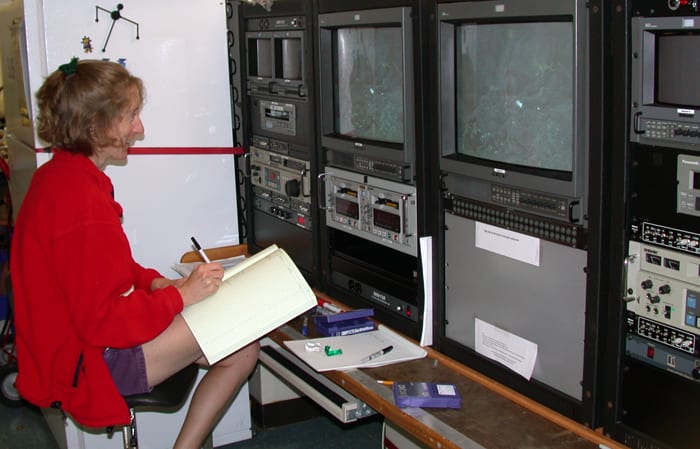 Research vessels are equipped with labs, such as this one on R/V Atlantis, where WHOI biologist Stace Beaulieu views images relayed from the human-occupied submersible Alvin from the seafloor. Ship labs include walk-in freezers, delicate microscopes, sonar and other acoustic devices, and of course, many, many computers. (Photo courtesy of Woods Hole Oceanographic Institution)
Research vessels are equipped with labs, such as this one on R/V Atlantis, where WHOI biologist Stace Beaulieu views images relayed from the human-occupied submersible Alvin from the seafloor. Ship labs include walk-in freezers, delicate microscopes, sonar and other acoustic devices, and of course, many, many computers. (Photo courtesy of Woods Hole Oceanographic Institution)- On a research ship, research is not confined to the labs. WHOI biologists Tim Shank (left), Stace Beaulieu (right), and another observer examine a tubeworm collected by the human-occupied submersible Alvin from hydrothermal vents along the Galápagos Rift. Alvin always sails on R/V Atlantis, which is equipped with a hangar to shelter the little sub during off-duty hours. (Photo courtesy of Woods Hole Oceanographic Institution)
- Accommodations on a research vessel are more spacious than on a military ship, but not as plush as on a cruise ship. This room on R/V Oceanus features bunk beds, personal storage area, seating for two, and a writing desk. (Photo by Marisa Hudspeth)
- Alvin pilot Bruce Strickrott looks over the offerings as steward Carl Wood refills the food trays in the mess hall of R/V Atlantis. Researchers and crew routinely report that meals aboard WHOI research ships are superb. (Photo by Christopher Knight)
Related Articles
Topics
Featured Researchers
See Also
- WHOI ships
- History of WHOI Research Vessels
- University-National Oceanographic Laboratory System (UNOLS)
- Replacing the Fleet An article in Oceanus by Dick Pittenger
- The Lo-o-o-ng Core from Oceanus magazine

